Page 13 of 506
▫Driver And Front Passenger Supplemental
Restraint System (SRS) - Airbags .......... 53
▫ Child Restraint ....................... 71
� Engine Break-In Recommendations .......... 80
� Safety Tips ........................... 81
▫ Transporting Passengers ................ 81 ▫
Exhaust Gas ......................... 81
▫ Safety Checks You Should Make Inside The
Vehicle ............................. 82
▫ Periodic Safety Checks You Should Make
Outside The Vehicle ................... 83
THINGS TO KNOW BEFORE STARTING YOUR VEHICLE 11
2
Page 44 of 506
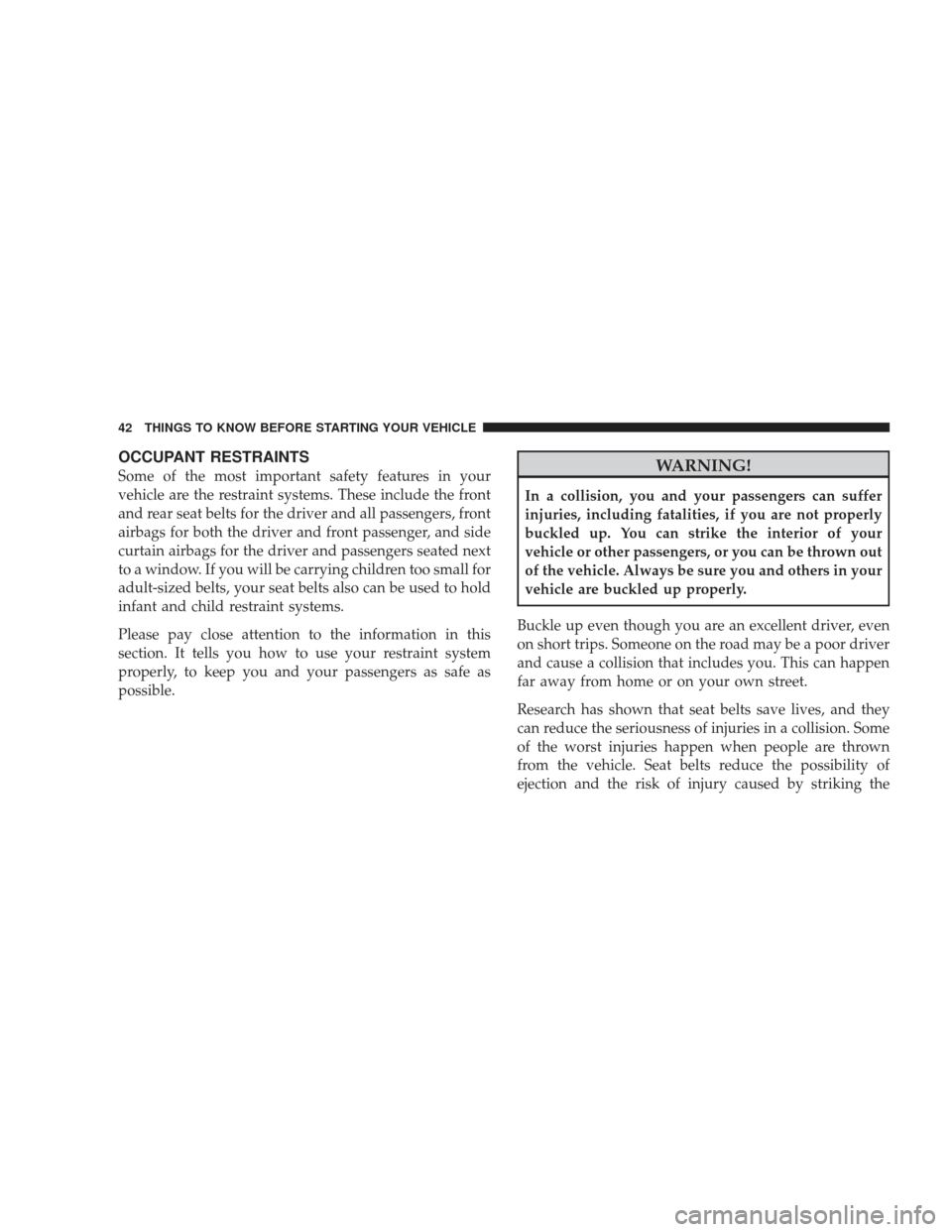
OCCUPANT RESTRAINTS
Some of the most important safety features in your
vehicle are the restraint systems. These include the front
and rear seat belts for the driver and all passengers, front
airbags for both the driver and front passenger, and side
curtain airbags for the driver and passengers seated next
to a window. If you will be carrying children too small for
adult-sized belts, your seat belts also can be used to hold
infant and child restraint systems.
Please pay close attention to the information in this
section. It tells you how to use your restraint system
properly, to keep you and your passengers as safe as
possible.WARNING!
In a collision, you and your passengers can suffer
injuries, including fatalities, if you are not properly
buckled up. You can strike the interior of your
vehicle or other passengers, or you can be thrown out
of the vehicle. Always be sure you and others in your
vehicle are buckled up properly.
Buckle up even though you are an excellent driver, even
on short trips. Someone on the road may be a poor driver
and cause a collision that includes you. This can happen
far away from home or on your own street.
Research has shown that seat belts save lives, and they
can reduce the seriousness of injuries in a collision. Some
of the worst injuries happen when people are thrown
from the vehicle. Seat belts reduce the possibility of
ejection and the risk of injury caused by striking the
42 THINGS TO KNOW BEFORE STARTING YOUR VEHICLE
Page 51 of 506
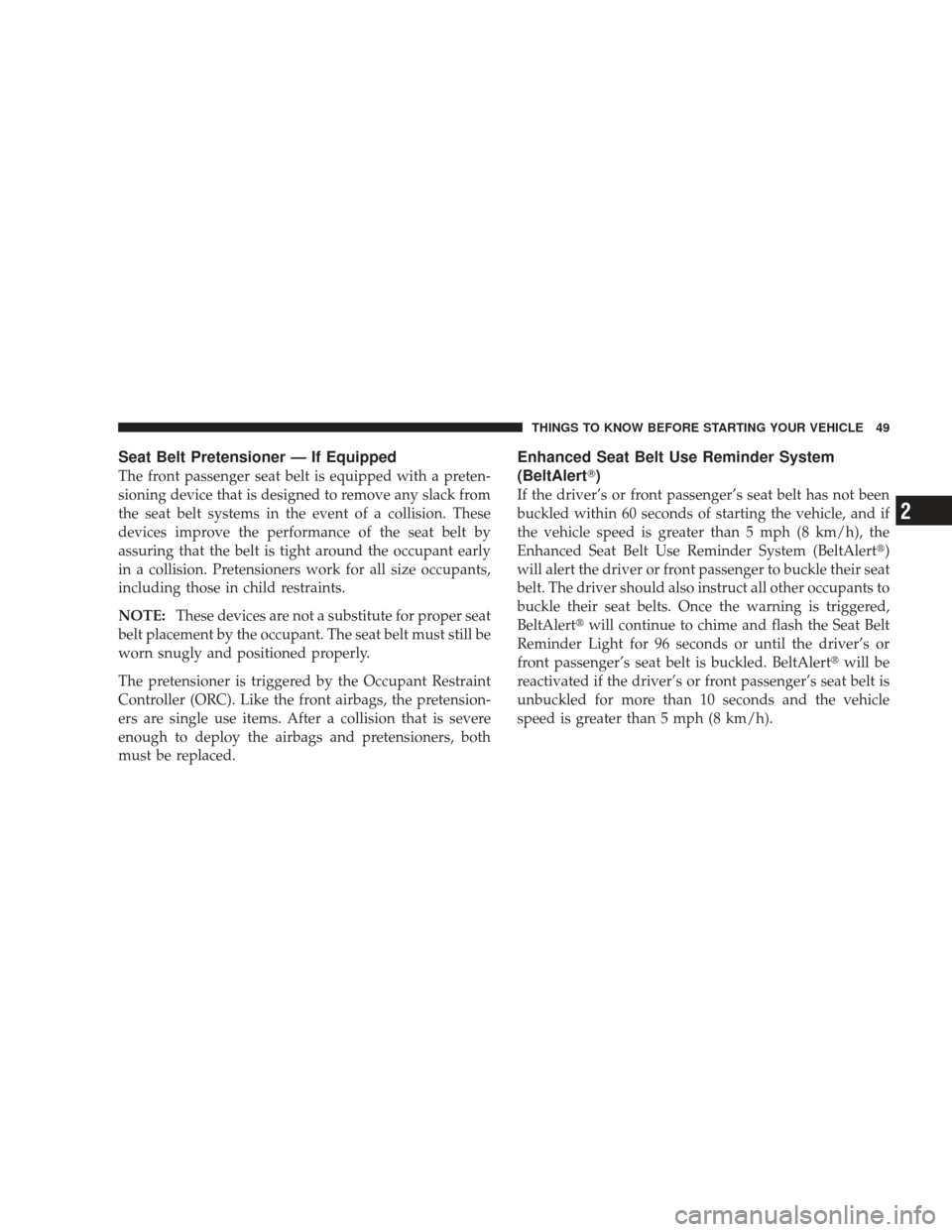
Seat Belt Pretensioner — If Equipped
The front passenger seat belt is equipped with a preten-
sioning device that is designed to remove any slack from
the seat belt systems in the event of a collision. These
devices improve the performance of the seat belt by
assuring that the belt is tight around the occupant early
in a collision. Pretensioners work for all size occupants,
including those in child restraints.
NOTE:These devices are not a substitute for proper seat
belt placement by the occupant. The seat belt must still be
worn snugly and positioned properly.
The pretensioner is triggered by the Occupant Restraint
Controller (ORC). Like the front airbags, the pretension-
ers are single use items. After a collision that is severe
enough to deploy the airbags and pretensioners, both
must be replaced.
Enhanced Seat Belt Use Reminder System
(BeltAlert�)
If the driver’s or front passenger’s seat belt has not been
buckled within 60 seconds of starting the vehicle, and if
the vehicle speed is greater than 5 mph (8 km/h), the
Enhanced Seat Belt Use Reminder System (BeltAlert�)
will alert the driver or front passenger to buckle their seat
belt. The driver should also instruct all other occupants to
buckle their seat belts. Once the warning is triggered,
BeltAlert� will continue to chime and flash the Seat Belt
Reminder Light for 96 seconds or until the driver’s or
front passenger’s seat belt is buckled. BeltAlert� will be
reactivated if the driver’s or front passenger’s seat belt is
unbuckled for more than 10 seconds and the vehicle
speed is greater than 5 mph (8 km/h).
THINGS TO KNOW BEFORE STARTING YOUR VEHICLE 49
2
Page 55 of 506
Driver and Front Passenger Supplemental
Restraint System (SRS) - Airbags
This vehicle has airbags for both the driver and front
passenger as a supplement to the seat belt restraint
systems. The driver’s airbag is mounted in the steering
wheel. The passenger’s front airbag is mounted in the
instrument panel, above the glove compartment. The
words SRS AIRBAG are embossed on the airbag covers.
1 — Driver Airbag
2 — Passenger AirbagTHINGS TO KNOW BEFORE STARTING YOUR VEHICLE 53
2
Page 56 of 506
NOTE:The front airbags are certified to the Federal
regulations that allow less forceful deployment.
The front airbags have a multistage inflator design. This
may allow the airbag to have different rates of inflation
that are based on collision severity and occupant size.
The front passenger airbag is also certified to the Federal
regulations that define Occupant Classification (refer to
information on Occupant Classification System in this
section).
This vehicle is equipped with side curtain airbags to
protect the driver and the front and rear passengers
sitting next to a window. They are located above the side
windows. Their covers are also labeled SRS AIRBAG. NOTE:
Airbag covers may not be obvious in the interior
trim; but they will open to allow airbag deployment.
Window Airbag Location
54 THINGS TO KNOW BEFORE STARTING YOUR VEHICLE
Page 57 of 506
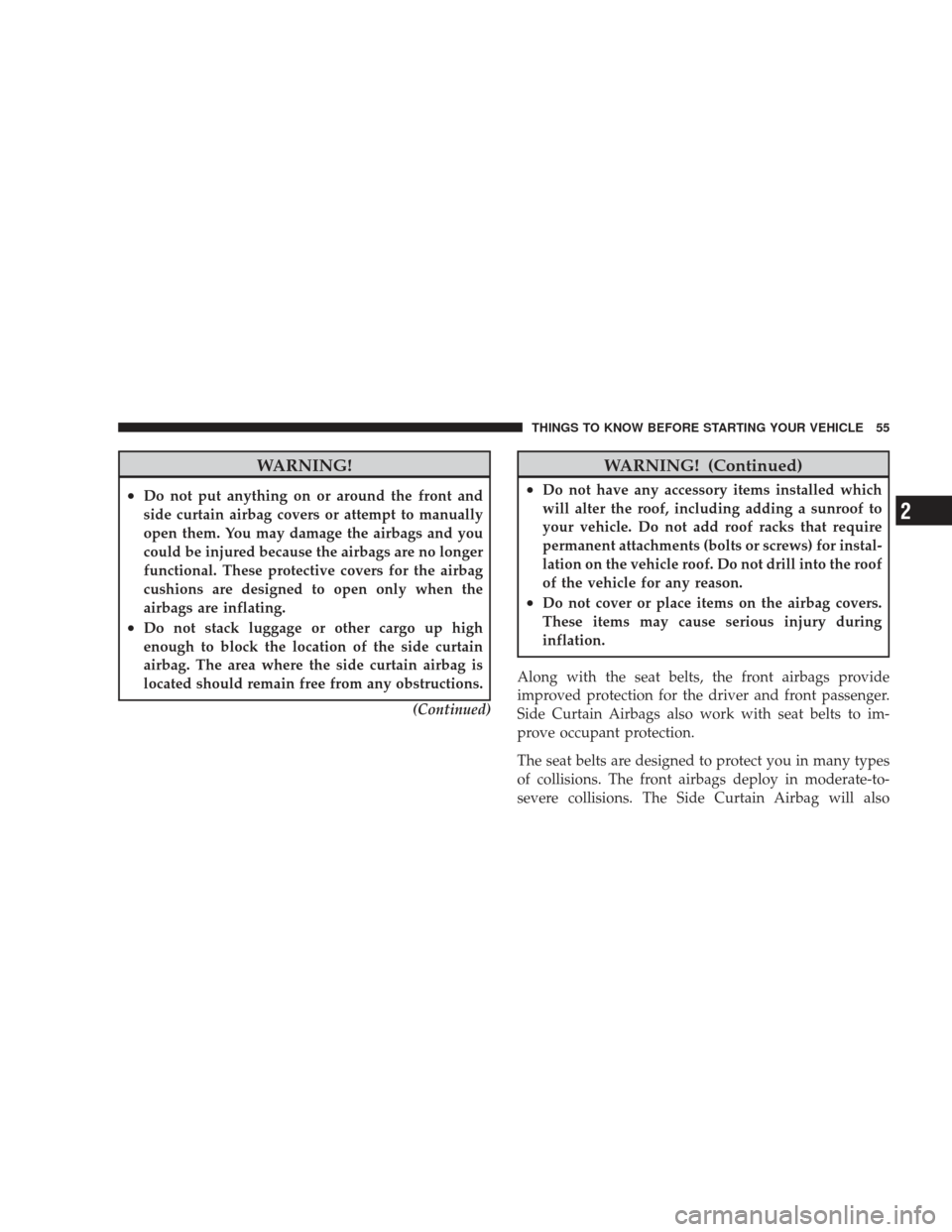
WARNING!
•Do not put anything on or around the front and
side curtain airbag covers or attempt to manually
open them. You may damage the airbags and you
could be injured because the airbags are no longer
functional. These protective covers for the airbag
cushions are designed to open only when the
airbags are inflating.
•Do not stack luggage or other cargo up high
enough to block the location of the side curtain
airbag. The area where the side curtain airbag is
located should remain free from any obstructions.(Continued)
WARNING! (Continued)
•Do not have any accessory items installed which
will alter the roof, including adding a sunroof to
your vehicle. Do not add roof racks that require
permanent attachments (bolts or screws) for instal-
lation on the vehicle roof. Do not drill into the roof
of the vehicle for any reason.
•Do not cover or place items on the airbag covers.
These items may cause serious injury during
inflation.
Along with the seat belts, the front airbags provide
improved protection for the driver and front passenger.
Side Curtain Airbags also work with seat belts to im-
prove occupant protection.
The seat belts are designed to protect you in many types
of collisions. The front airbags deploy in moderate-to-
severe collisions. The Side Curtain Airbag will also
THINGS TO KNOW BEFORE STARTING YOUR VEHICLE 55
2
Page 58 of 506
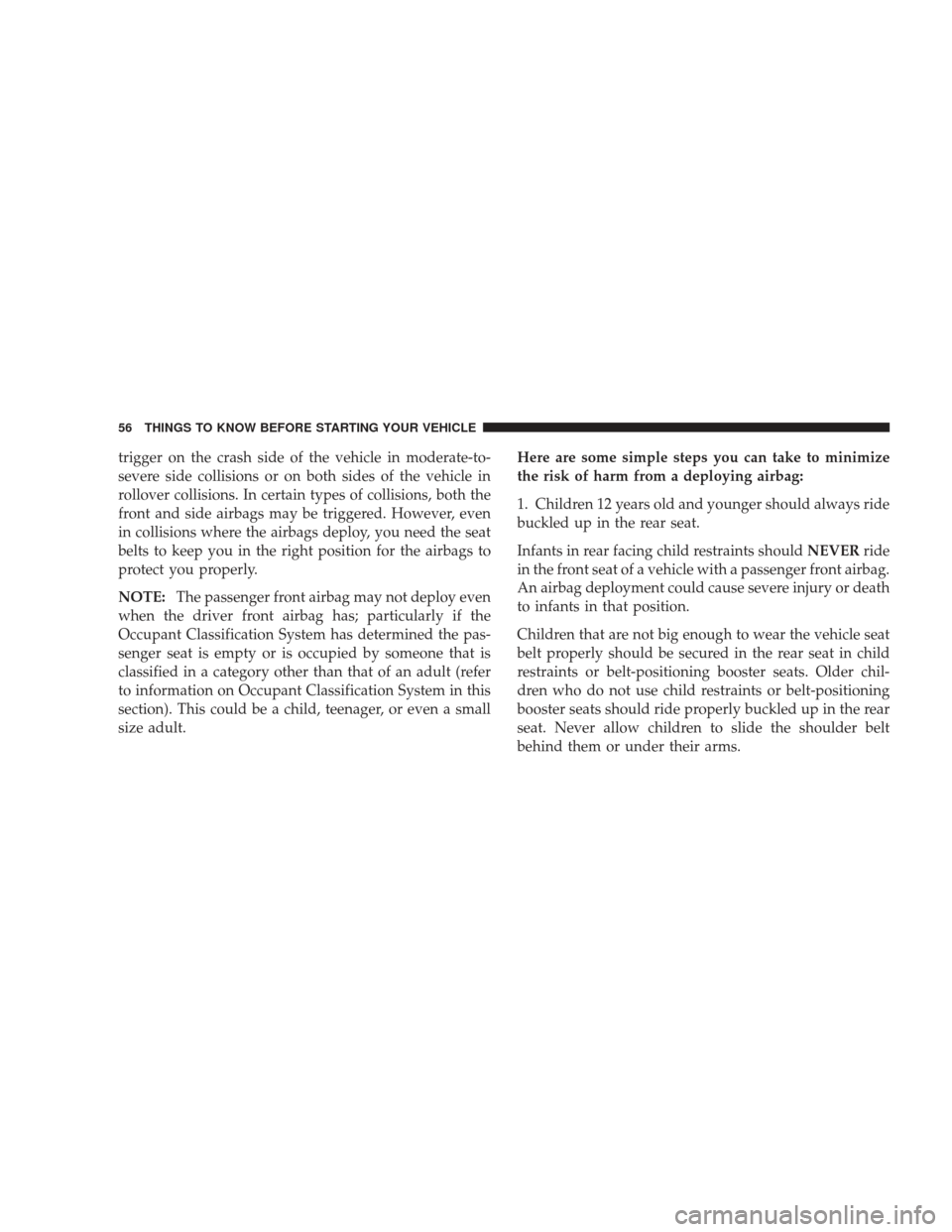
trigger on the crash side of the vehicle in moderate-to-
severe side collisions or on both sides of the vehicle in
rollover collisions. In certain types of collisions, both the
front and side airbags may be triggered. However, even
in collisions where the airbags deploy, you need the seat
belts to keep you in the right position for the airbags to
protect you properly.
NOTE:The passenger front airbag may not deploy even
when the driver front airbag has; particularly if the
Occupant Classification System has determined the pas-
senger seat is empty or is occupied by someone that is
classified in a category other than that of an adult (refer
to information on Occupant Classification System in this
section). This could be a child, teenager, or even a small
size adult. Here are some simple steps you can take to minimize
the risk of harm from a deploying airbag:
1. Children 12 years old and younger should always ride
buckled up in the rear seat.
Infants in rear facing child restraints should
NEVERride
in the front seat of a vehicle with a passenger front airbag.
An airbag deployment could cause severe injury or death
to infants in that position.
Children that are not big enough to wear the vehicle seat
belt properly should be secured in the rear seat in child
restraints or belt-positioning booster seats. Older chil-
dren who do not use child restraints or belt-positioning
booster seats should ride properly buckled up in the rear
seat. Never allow children to slide the shoulder belt
behind them or under their arms.
56 THINGS TO KNOW BEFORE STARTING YOUR VEHICLE
Page 59 of 506
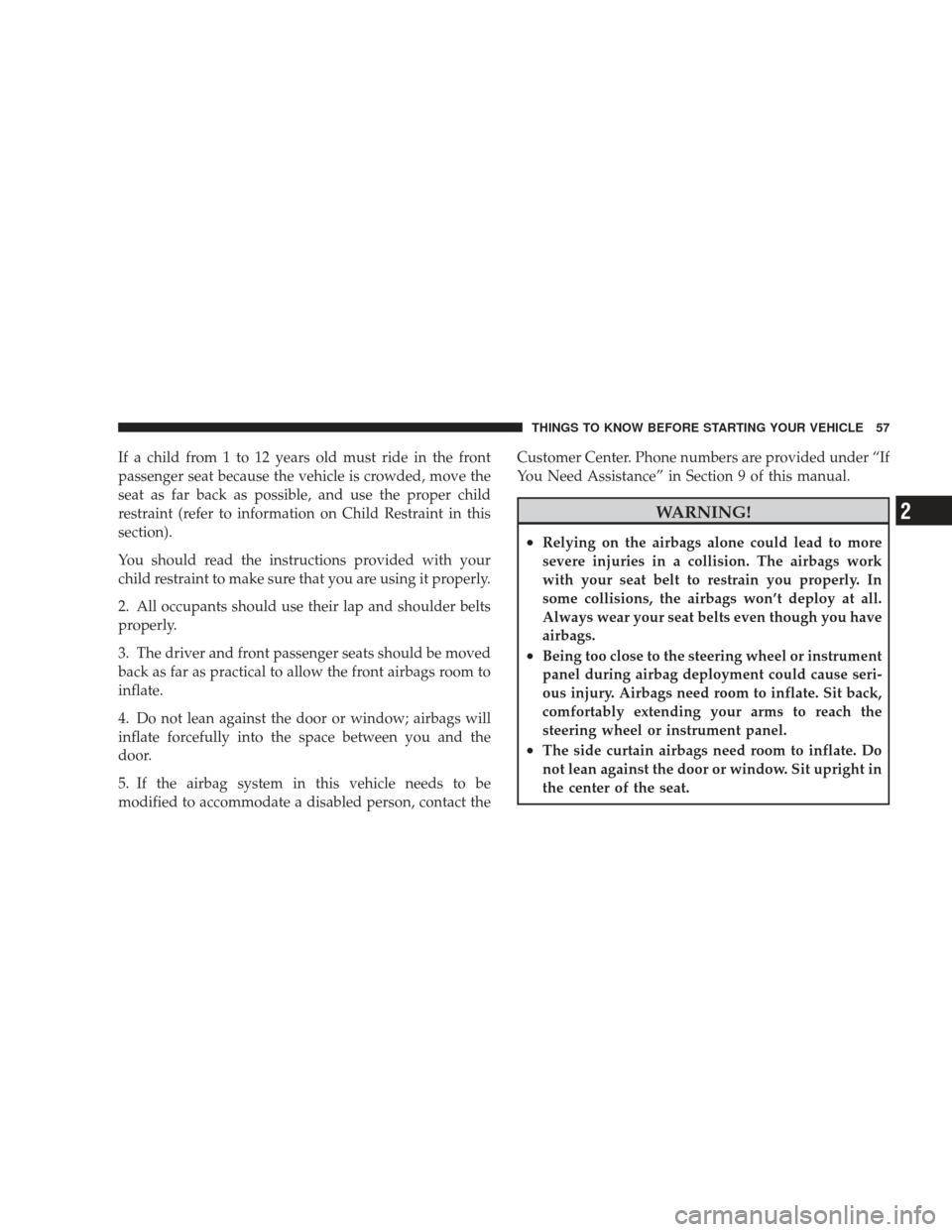
If a child from 1 to 12 years old must ride in the front
passenger seat because the vehicle is crowded, move the
seat as far back as possible, and use the proper child
restraint (refer to information on Child Restraint in this
section).
You should read the instructions provided with your
child restraint to make sure that you are using it properly.
2. All occupants should use their lap and shoulder belts
properly.
3. The driver and front passenger seats should be moved
back as far as practical to allow the front airbags room to
inflate.
4. Do not lean against the door or window; airbags will
inflate forcefully into the space between you and the
door.
5. If the airbag system in this vehicle needs to be
modified to accommodate a disabled person, contact theCustomer Center. Phone numbers are provided under “If
You Need Assistance” in Section 9 of this manual.
WARNING!
•Relying on the airbags alone could lead to more
severe injuries in a collision. The airbags work
with your seat belt to restrain you properly. In
some collisions, the airbags won’t deploy at all.
Always wear your seat belts even though you have
airbags.
•Being too close to the steering wheel or instrument
panel during airbag deployment could cause seri-
ous injury. Airbags need room to inflate. Sit back,
comfortably extending your arms to reach the
steering wheel or instrument panel.
•The side curtain airbags need room to inflate. Do
not lean against the door or window. Sit upright in
the center of the seat.
THINGS TO KNOW BEFORE STARTING YOUR VEHICLE 57
2